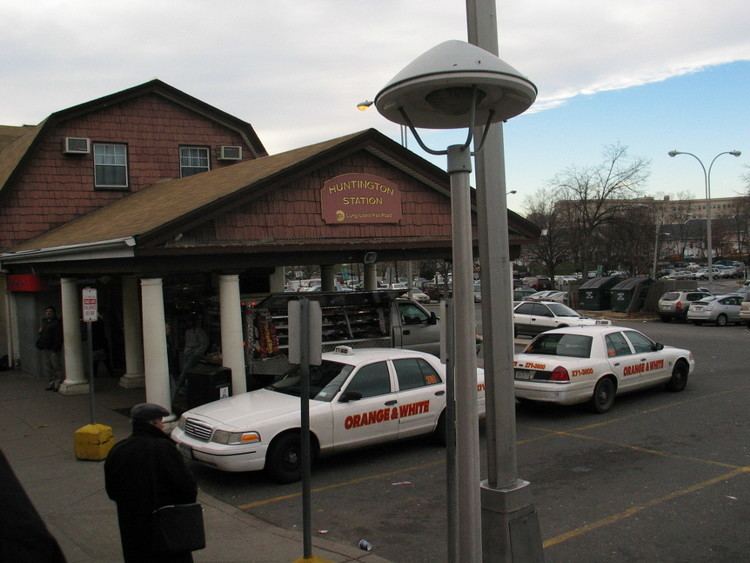Owned by MTA Parking 5,040 spaces Opened 13 January 1868 Tracks 2 Platforms in use 2 | Line(s) Port Jefferson Branch Bicycle facilities Yes Phone +1 718-217-5477 Rebuilt 1909 | |
 | ||
Location New York Avenue & Broadway
Huntington Station, New York Connections Suffolk County Transit: S1
Huntington Area Rapid Transit: H9, Blue, Red shuttles Address New York Ave 110 & Broadway, Huntington Station, NY 11757, USA Owner Metropolitan Transportation Authority Similar Hewlett, Hempstead Gardens, Cold Spring Harbor, Medford, Greenlawn | ||
Huntington is a station on the Port Jefferson Branch of the Long Island Rail Road. It is located near New York Avenue (NY 110), connecting it to Melville, the Long Island Expressway and Huntington and Broadway in Huntington Station, New York, but is also accessible from Lenox Road and Fairground Avenue near East Second Street. This train station is located in the Huntington Union Free School District. It is also approximately 37.2 miles (59.3 km) from Penn Station in Midtown Manhattan.
Contents
History
Huntington station opened on January 13, 1868, amidst a great deal of controversy between the people of Huntington and Oliver Charlick over the right-of-way and station location which the people wanted directly within Huntington Village, specifically at Main Street and New York Avenue. Instead, the station is located approximately 1.5 miles (2.4 km) south of the village in a hamlet originally known as "Fairground," because of a disagreement with Charlick and the Joneses, an affluent family that resided in the area.
Throughout much of the 20th century, the station served as a hub. One reason for this was that it also served as the southern terminus of the Huntington Trolley Spur between 1890 and 1909. The trolley was electrified on June 17, 1898, and extended towards Melville, Farmingdale, and Amityville in 1909. The trolley ran between Halesite and Amityville until 1919, and was replaced in 1920 by another trolley which only ran as far south as Jericho Turnpike until 1927.
The grade crossing at New York Avenue was eliminated between 1908 and 1909, which also required the relocation of the original station building, which was located south of the present structure. The current station building was built in 1909 and was renovated by the Long Island Rail Road for its centennial.
On October 19, 1970, the Port Jefferson Branch was electrified up to Huntington and high-level platforms were added. The station also became a transfer point for diesel trains serving the non-electrified portion of the branch, requiring most passengers traveling to and from points east to change at Huntington.
The first parking garage was constructed on the south side of the station in the 1980s. The following decade, Huntington Station saw major reconstruction that included the addition of handicap-accessible ramps, a second parking garage on the north side of the station, a second pedestrian bridge across both tracks, and a pedestrian bridge across New York Avenue.
The station boasts a series of 19 stunning stained glass panels that can be viewed from the platform. They were created as part of the Metropolitan Transit Authority's Arts for Transit program by artist Joe Zucker. The panels are called For My Grandfather Noye Pride, a Locomotive Engineer, and make up a 115-foot depiction of a flatbed train carrying items familiar to Long Island including lobsters, whales, ducks and boats. Mr. Zucker is from East Hampton. He said, It was a chance to pay tribute to my grandfather, who was a locomotive engineer working on western railroads in Wisconsin and Illinois. The panels were created by master craftsman Helmut Schardt of East Northport, and were made with 8,000 pieces of glass.
The station currently has a total of 5,040 parking spaces, including 3,500 spaces in two garages on opposite sides of the tracks. The north garage will be renovated in 2010 using $1 million of Federal Stimulus funding.
Transit-oriented development
As one of the busiest stations on the LIRR, Huntington is a prime target for transit-oriented development. Currently, the largest proposal for TOD is Avalon Huntington Station, which will occupy a nearby lot southwest of the station and will contain 530 residential units in a walkable, mixed-use development.
Station layout
The station has two high-level side platforms, each 12 cars long, along the two tracks. Transfers between diesel and electric trains are usually made on the north platform, with a diesel train following an electric train (or vice versa). The LIRR had plans to build an enormous electric equipment maintenance facility, but the project was cancelled due to community opposition. Just east of the station, there is a twenty-four-car-long siding, in replacement of the unbuilt yard. Electrification ends about 600 feet (180 m) west of Lake Road.
